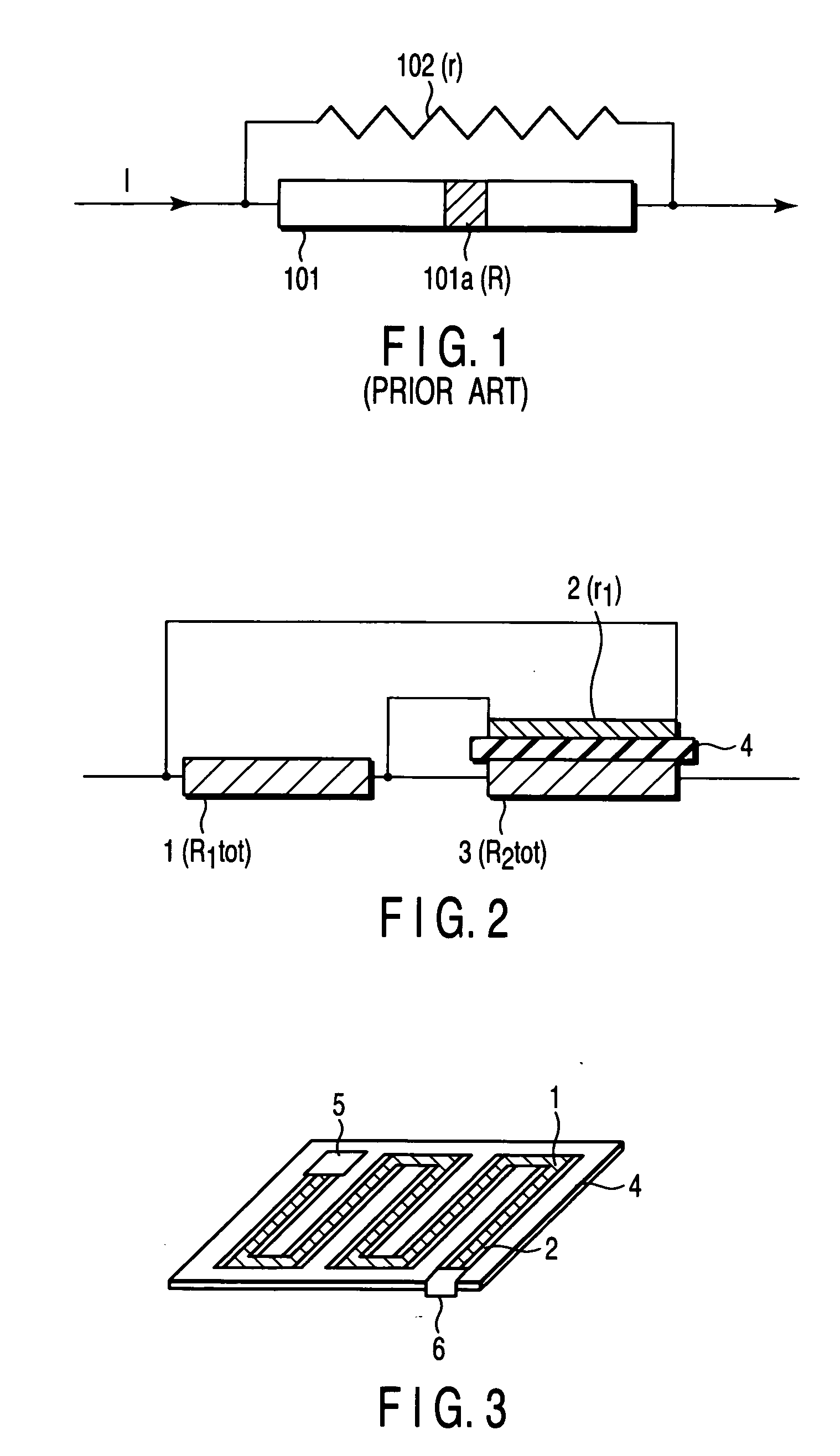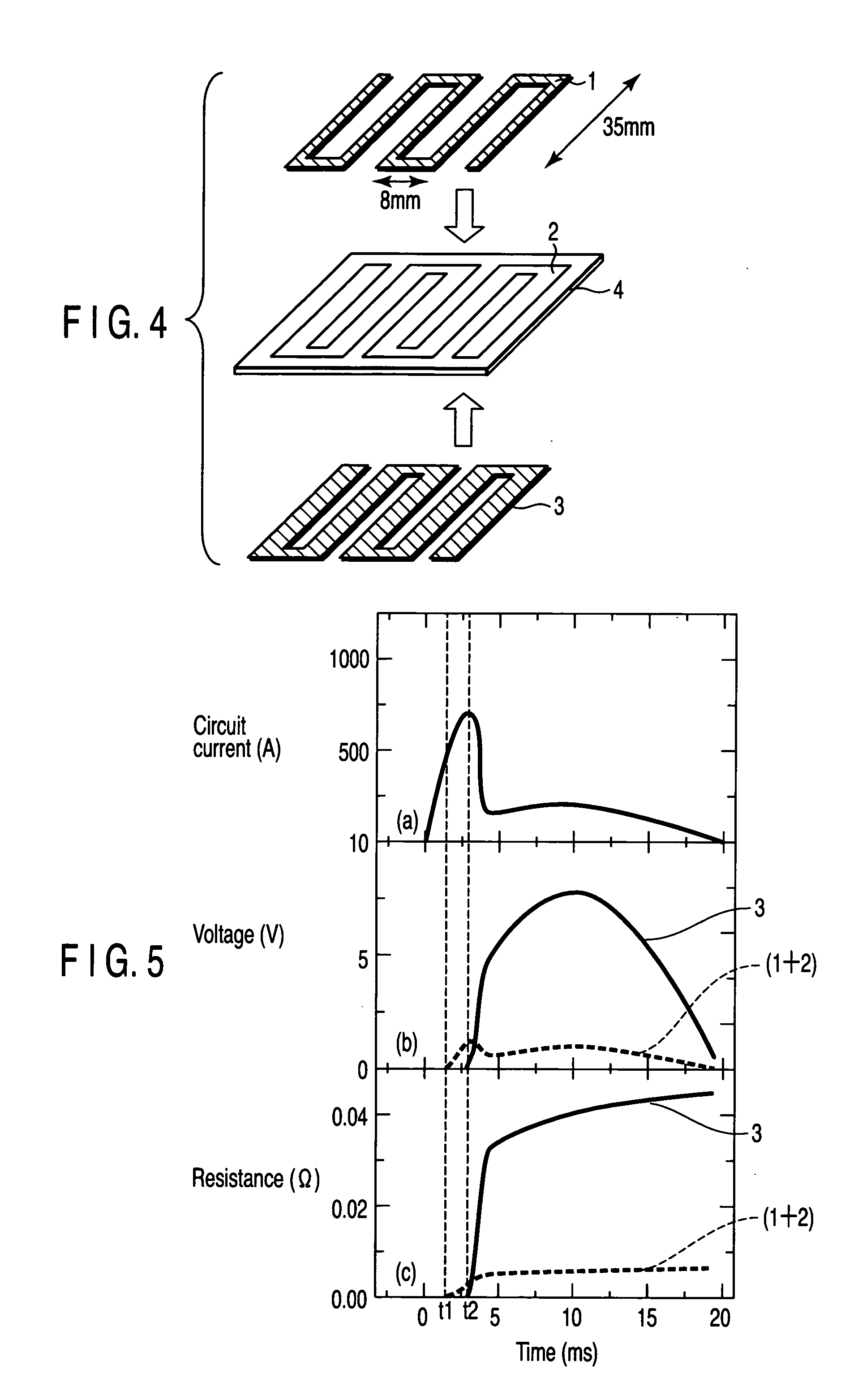Superconducting current limiting element
superconducting technology, applied in the direction of superconductor devices, superconductor emergency protection arrangements for limiting excess voltage/current, etc., can solve the problems of damage to the superconductor, superconductor cannot be used as a current limiting element, and large amount of joule heat generation
- Summary
- Abstract
- Description
- Claims
- Application Information
AI Technical Summary
Benefits of technology
Problems solved by technology
Method used
Image
Examples
example 1
[0045]FIG. 3 is a perspective view of the superconducting current limiting element in this example. FIG. 4 is an exploded perspective view of the superconducting current limiting element in this example.
[0046] A normal conductor 2 made of a Ni thin film and processed into a meander shape was formed on one surface (upper surface) of an insulating substrate 4 made of sapphire having a thickness of 1 mm. A first superconductor 1 processed into a meander shape was formed on the normal conductor 2. In this case, a Y-based bulk superconductor was lapped into a plate having a thickness of 0.3 mm, and the plate was further processed into a meander-shaped strip having a width of 1 mm, and the resultant strip was used for the first superconductor 1. The total length of the first superconductor was about 200 mm. The first superconductor 1 was coated with a thin silver paste on one surface thereof, which was adhered to the normal conductor 2. A second superconductor 3 processed into a meander ...
example 2
[0054]FIG. 7 is a perspective view showing the upper surface of the superconducting current limiting element in this example. FIG. 8 is a perspective view showing the lower surface of the superconducting current limiting element in this example.
[0055] A Ni thin film was deposited on the upper surface of an insulating substrate 4 made of sapphire having a width of 5 cm, a length of 15 cm, and a thickness of 1 mm, and processed into a strip having a width of 3 cm and a length of 12 cm to form a normal conductor 2. As a first superconductor 1, a wire made of a Y-based superconducting thin film deposited on a metal tape having a thickness of 100 μm, a width of 1 cm, and a length of 12 cm was used. The metal tape having the first superconductor 1 thereon was adhered to the normal conductor 2 made of the Ni thin film using epoxy resin. As a second superconductor 3, a Y-based superconducting thin film deposited on CeO2 by an MOD method, which was epitaxially deposited on an R-plane sapphi...
example 3
[0062]FIG. 10 is a perspective view showing a superconductor conducting current limiting element in this example. FIG. 11 is an exploded perspective view showing the upper surface of the superconducting current limiting element in this example. FIG. 12 is an exploded perspective view showing the lower surface of the superconducting current limiting element in this example.
[0063] Example 3 is different from Example 2 in that, as a first superconductor 1, a Y-based superconducting thin film epitaxially deposited on CeO2 by evaporation, which was epitaxially deposited on a sapphire substrate having a thickness of 1 mm, a width of 1 cm, and a length of 12 cm, was used. Other constitution was similar to that of Example 2.
[0064] The first superconductor 1 had Ic of about 130 Å and the second superconductor 3 had Ic of about 200 Å, respectively, under the liquid nitrogen temperature. In this Example 3, the Ic of the first superconductor 1, which determines a current capacity of a current...
PUM
| Property | Measurement | Unit |
|---|---|---|
| thickness | aaaaa | aaaaa |
| width | aaaaa | aaaaa |
| thickness | aaaaa | aaaaa |
Abstract
Description
Claims
Application Information
 Login to View More
Login to View More - R&D
- Intellectual Property
- Life Sciences
- Materials
- Tech Scout
- Unparalleled Data Quality
- Higher Quality Content
- 60% Fewer Hallucinations
Browse by: Latest US Patents, China's latest patents, Technical Efficacy Thesaurus, Application Domain, Technology Topic, Popular Technical Reports.
© 2025 PatSnap. All rights reserved.Legal|Privacy policy|Modern Slavery Act Transparency Statement|Sitemap|About US| Contact US: help@patsnap.com



